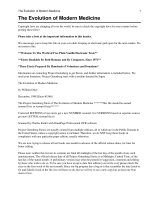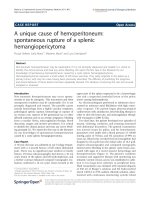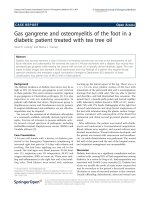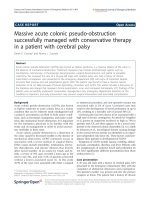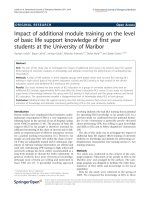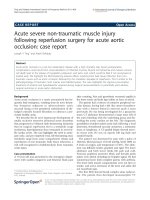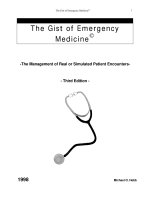Professor of emergency Medicine
Bạn đang xem bản rút gọn của tài liệu. Xem và tải ngay bản đầy đủ của tài liệu tại đây (6.02 MB, 291 trang )
Also in the Self-Assessment Color Review series:
Brennan: Paediatric Emergency Medicine
Chapman: Hepatobiliary Medicine
Copley: Thoracic Medicine
Evans: Clinical Anatomy
Forbes: Neuroimaging
Goodship: Renal Medicine
Horst: General Critical Care
Kitchen: Clinical Neurology and Neurosurgery
Marks: Dermatology
Rosen: Cardiology 2nd edition
Spiro: Respiratory Medicine 3rd edition
Self-Assessment
Color Review
The book will appeal to a wide readership, ranging from trainees to
practitioners in emergency medicine or primary care, for examination
revision and continuing education.
Adult Emergency Medicine
Each case consists of one or more questions, illustrated by stimulating
visual material including clinical photographs, imaging and
electrocardiograms. Answers and full discussion then follow covering
differential and definitive diagnoses, management and subtle insights to
provide optimal care and prevent complications.
Self-Assessment
Color Review
This new volume in the established and wellrespected series of Self-Assessment Color Reviews covers all
aspects of adult emergency medicine. Over 250 cases are presented
randomly to reflect real-life practice.
LEARN • REVISE • REINFORCE
Adult
Emergency
Medicine
John F O’Brien
O’Brien
Clinical cases
Problem based
Fully illustrated
ISBN: 978-1-84076-178-8
MANSON
PUBLISHING
O’Brien cover CMYK
O'Brien prelims final v7.qxp:MANSON
10/24/12
8:00 PM
Page 1
Self-Assessment Color Review
Adult Emergency
Medicine
John F O’Brien
MD
Associate Program Director/Emergency Medicine Residency
Orlando Regional Medical Center
Orlando, Florida, USA
Clinical Associate Professor of Emergency Medicine
University of Central Florida College of Medicine
Orlando, Florida, USA
Associate Professor of Emergency Medicine
Faculty of Emergency Medicine
University of Florida College of Medicine
Gainesville, Florida, USA
MANSON
PUBLISHING
O'Brien prelims final v7.qxp:MANSON
10/24/12
8:00 PM
Page 2
Acknowledgements
I would like to thank several people who were instrumental in helping create this
textbook. Many of my colleagues in Orlando helped with finding interesting cases,
particularly Dr. Mark Clark. Several emergency medicine residents served as primary
reviewers for much of the material in this endeavor, particularly Dr. Clifford Denney.
My son, Nathan O’Brien, who recently completed his medical school training at
Vanderbilt University and has begun his post-graduate training in emergency medicine,
was perhaps the most detailed reviewer of all. The formal reviewers, Dr. John Younger
and Dr. Peter Thomas, added many specific suggestions for improving the case
discussions. Peter Beynon was a great help in word crafting the discussions to make
them more interesting and succinct. Paul Bennett was instrumental in formatting the
cases into an attractive casebook. My commissioning editor at Manson Publishing, Jill
Northcott, was ever supportive in helping me accomplish this complicated task. Last,
but most importantly, I wish to thank my wonderful wife Rhonda, who served as
primary typist, organizer, and encourager. Without her tremendous help it is unlikely
this would have ever been completed.
Copyright © 2013 Manson Publishing Ltd
ISBN: 978-1-84076-178-8
All rights reserved. No part of this publication may be reproduced, stored in a retrieval system
or transmitted in any form or by any means without the written permission of the copyright
holder or in accordance with the provisions of the Copyright Act 1956 (as amended), or
under the terms of any licence permitting limited copying issued by the Copyright Licensing
Agency, 33–34 Alfred Place, London WC1E 7DP, UK.
Any person who does any unauthorized act in relation to this publication may be liable to
criminal prosecution and civil claims for damages.
A CIP catalogue record for this book is available from the British Library.
For full details of all Manson Publishing Ltd titles please write to:
Manson Publishing Ltd, 73 Corringham Road, London NW11 7DL, UK.
Tel: +44(0)20 8905 5150
Fax: +44(0)20 8201 9233
Email:
Website: www.mansonpublishing.com
Commissioning editor: Jill Northcott
Project manager: Paul Bennett
Copy editor: Peter Beynon
Design and layout: Cathy Martin
Colour reproduction: Tenon & Polert Colour Scanning Ltd, Hong Kong
Printed by: New Era Printing Company Ltd, Hong Kong
CRC Press
Taylor & Francis Group
6000 Broken Sound Parkway NW, Suite 300
Boca Raton, FL 33487-2742
© 2013 by Taylor & Francis Group, LLC
CRC Press is an imprint of Taylor & Francis Group, an Informa business
No claim to original U.S. Government works
Version Date: 20140110
International Standard Book Number-13: 978-1-84076-632-5 (eBook - PDF)
This book contains information obtained from authentic and highly regarded sources. While all reasonable efforts
have been made to publish reliable data and information, neither the author[s] nor the publisher can accept any
legal responsibility or liability for any errors or omissions that may be made. The publishers wish to make clear that
any views or opinions expressed in this book by individual editors, authors or contributors are personal to them
and do not necessarily reflect the views/opinions of the publishers. The information or guidance contained in this
book is intended for use by medical, scientific or health-care professionals and is provided strictly as a supplement
to the medical or other professional’s own judgement, their knowledge of the patient’s medical history, relevant
manufacturer’s instructions and the appropriate best practice guidelines. Because of the rapid advances in medical
science, any information or advice on dosages, procedures or diagnoses should be independently verified. The reader
is strongly urged to consult the drug companies’ printed instructions, and their websites, before administering any
of the drugs recommended in this book. This book does not indicate whether a particular treatment is appropriate
or suitable for a particular individual. Ultimately it is the sole responsibility of the medical professional to make his
or her own professional judgements, so as to advise and treat patients appropriately. The authors and publishers
have also attempted to trace the copyright holders of all material reproduced in this publication and apologize to
copyright holders if permission to publish in this form has not been obtained. If any copyright material has not been
acknowledged please write and let us know so we may rectify in any future reprint.
Except as permitted under U.S. Copyright Law, no part of this book may be reprinted, reproduced, transmitted,
or utilized in any form by any electronic, mechanical, or other means, now known or hereafter invented, including photocopying, microfilming, and recording, or in any information storage or retrieval system, without written
permission from the publishers.
For permission to photocopy or use material electronically from this work, please access www.copyright.com (http://
www.copyright.com/) or contact the Copyright Clearance Center, Inc. (CCC), 222 Rosewood Drive, Danvers, MA
01923, 978-750-8400. CCC is a not-for-profit organization that provides licenses and registration for a variety of
users. For organizations that have been granted a photocopy license by the CCC, a separate system of payment has
been arranged.
Trademark Notice: Product or corporate names may be trademarks or registered trademarks, and are used only for
identification and explanation without intent to infringe.
Visit the Taylor & Francis Web site at
and the CRC Press Web site at
O'Brien prelims final v7.qxp:MANSON
10/24/12
8:00 PM
Page 3
Preface
The provision of competent emergency medical care is frequently both challenging and
exhilarating. An ever-expanding knowledge base is necessary, coupled with clinical
judgement and the ability to process often quite complex information. Much can be
gained from experience in the emergency medicine clinical arena, and this selfassessment book attempts to assist in that endeavor through a case-based approach.
Using a series of common as well as more unusual presentations, this text attempts to
inform and refresh the reader across the entire spectrum of adult emergency medicine.
Although pediatrics is not covered in these pages, a similar case book specific to children
is available through this publisher. Medical trainees and qualified practitioners working
not only in general emergency medicine, but also in primary care and other specialties,
may use these cases to test and refine their abilities to care for a wide variety of patients.
This book employs questions to stimulate the reader to think about the evaluation
and management of each patient, using a combination of photographs, radiographs,
electrocardiograms, and other data. Discussions ensue, which should highlight various
aspects of the case including differential diagnoses, management issues, and subtle
insights to provide optimal care and prevent complications. Please enjoy the ride as you
assimilate much of what is necessary to practice the art of emergency medicine.
Note that regional variations in the provision of emergency care exist. The reader
should feel free to add to the learning experience by exploring the references attached
to each case. In addition, specific practice guidelines should be sought from reliable
local resources and societies. Clearly, a variety of management techniques can be
thoughtfully applied to many clinical situations, and this book can only provide some
evidence-based approaches.
John O’Brien
Classification of cases
Cardiology
1, 16, 45, 57, 73, 75, 91, 94, 102, 108,
112, 114, 120, 128, 131, 146, 147, 153,
157, 163, 165, 167, 176, 178, 182, 191,
197, 203, 207, 209, 217, 220, 225, 227,
232, 239, 245
Dermatology
18, 19, 24, 32, 38, 72, 76, 103, 110,
121, 127, 145, 162, 175, 181, 183, 184,
199, 208, 229, 233, 237, 242
Gastroenterology
5, 27, 35, 50, 62, 64, 74, 83, 100, 104,
115, 125, 139, 143, 151, 170, 173, 179,
195, 215, 246
Genitourinary
17, 42, 43, 47, 51, 52, 54, 71, 99, 118,
150, 161, 168, 211, 219, 231
Infectious disease
6, 11, 21, 25, 49, 68, 70, 82, 93, 101,
113, 119, 123, 124, 130, 132, 133, 152,
177, 223, 226, 250
Miscellaneous
12, 37, 41, 58, 59, 86, 87, 105, 111,
116, 141, 146, 159, 169, 189, 193, 198,
210, 221, 224, 249
3
O'Brien prelims final v7.qxp:MANSON
10/24/12
8:00 PM
Page 4
Neurology
23, 24, 40, 60, 66, 67, 96, 107, 166,
180, 201, 234, 235
Pulmonary
4, 30, 53, 55, 61, 65, 78, 79, 106, 109,
137, 156, 196, 212, 244
Orthopedics
2, 7, 9, 20, 28, 34, 48, 77, 80, 85, 88,
95, 98, 117, 126, 136, 138, 154, 155,
158, 171, 204, 206, 240, 243, 247
Toxicology
8, 10, 14, 22, 26, 33, 39, 69, 92, 122,
135, 144, 187, 213, 236, 248
Ophthalmology
29, 31, 44, 63, 90, 149, 160, 164, 185,
200, 205, 238, 241
Trauma
3, 13, 15, 36, 46, 81, 84, 89, 97, 129,
134, 140, 142, 172, 174, 186, 188, 190,
192, 194, 202, 214, 216, 222, 228, 230
Abbreviations
ABC
airway, breathing, and
circulation
AIDS
acquired immunodeficiency
syndrome
beta-hCG beta human chorionic
gonadotropin
BP
blood pressure
bpm
beats per minute
CBC
complete blood count
CNS
central nervous system
COPD
chronic obstructive
pulmonary disease
CPR
cardiopulmonary
resuscitation
CSF
cerebrospinal fluid
CT
computerized tomography
DBP
diastolic blood pressure
ECG
electrocardiogram
ELISA
enzyme-linked
immunosorbent assay
FAST
focused assessment by
sonography in trauma
GABA
gamma-aminobutyric acid
HAART highly active anti-retroviral
therapy
4
HIV
INR
IV
LAD
MRA
MRI
NSAID
NSR
P
Pox
PCR
RBCs
RNA
RR
SAH
SBP
STEMI
T
WBCs
human immunodeficiency
virus
international normalized
ratio
intravenous/intravenously
left anterior descending
(artery)
magnetic resonance
angiography
magnetic resonance imaging
nonsteroidal antiinflammatory drug
normal sinus rhythm
pulse
pulse oximetry
polymerase chain reaction
red blood cells
ribonucleic acid
respiratory rate
subarachnoid hemorrhage
systolic blood pressure
ST segment elevation
myocardial infarction
temperature
white blood cells
O'Brien final.qxp:SACR
10/16/12
10:17 PM
Page 5
1, 2: Questions
1
1 A 49-year-old male had diabetes mellitus and known hyperlipidemia. He
presented with 2 hours of severe precordial chest pain, shortness of breath, and
nausea. He appeared ill and was very diaphoretic.
i. What does this ECG suggest (1)?
ii. What are indications for reperfusion therapy?
2
2 A 34-year-old male sustained this injury when he twisted his ankle while running
(2).
i. What is the diagnosis?
ii. What associated complications are likely, and how should they be managed?
5
O'Brien final.qxp:SACR
10/16/12
10:17 PM
Page 6
1, 2: Answers
1 i. The ECG demonstrates normal sinus rhythm at about 70 bpm (premature atrial
contraction in sixth beat). ST segments are elevated over 1 mm in lateral leads (I and
aVL), with slight reciprocal ST depression in inferior leads III and aVF. T waves are
inverted in leads V4 to V6. This is consistent with acute lateral wall myocardial
infarction. Cardiac catheterization revealed acute LAD coronary artery occlusion.
ii. Rapid and aggressive management of acute myocardial infarction greatly reduces
morbidity and mortality. New ST elevation of 1 mm or more in contiguous
associated leads, in the setting of chest pain or anginal equivalents of recent onset
(usually <6 hours from symptom onset, but even longer if stuttering course or
ongoing ischemia), mandates reperfusion therapy. Associated leads are as follows:
inferior leads: II, III, and aVF; lateral leads: I, aVL, V5, and V6; anterior leads: V1
to V4; posterior leads: V7 to V9; right ventricular leads: right-sided V1 to V6
(particularly right V4). ECG changes for posterior wall myocardial infarction are
seen indirectly in anterior precordial leads, with tall R waves in V1 to V3 with ST
segment depression and upright T waves. New onset of left bundle branch block
with suspected ongoing ischemia is also an indication for reperfusion therapy. Serial
ECGs, and comparison to previous ones, is often helpful in borderline cases.
2 i. This is an open medial ankle injury, usually due to an eversion and external
rotation mechanism. Associated deltoid ligament injury or medial malleolus
avulsion is likely, and a spiral distal fibular fracture is usually present. Rarely,
deltoid ligament or medial malleolus injuries are associated with a tear in the
tibiofibular syndesmosis, often with a proximal fibular fracture. This is termed a
Maisonneuve fracture and may lead to chronic ankle instability if not recognized
and managed correctly. Occasionally, an open ankle can occur without fracture,
particularly with penetrating trauma. Careful neurovascular examination is
important. Simple radiographs are usually adequate to assess for fracture, with CT
reserved for complex fractures.
ii. Liberal analgesia is indicated. Neurovascular status may be compromised by
dislocation, in which case prompt reduction is indicated. Open fractures should be
covered by wet sterile dressings. Broad-spectrum antibiotics and tetanus
prophylaxis are indicated. Early orthopedic consultation is important since joint
irrigation, exploration, and surgical repair are necessary.
6
O'Brien final.qxp:SACR
10/16/12
10:17 PM
Page 7
3, 4: Questions
3 A 32-year-old male presented 30 minutes after being an unrestrained passenger
in a motor vehicle collision. He was talking, but a bit combative. BP was
80/54 mmHg (10.7/7.2 kPa) and P 156 bpm. He had clear lungs, a stable pelvis, no
extremity injuries, and no evidence of significant external bleeding. He had
moderate left upper quadrant pain.
i. What is the appropriate evaluation and management of this patient?
ii. Discuss some of the controversies in management?
4
50 mmHg (6.7 kPa)
CO2
0 mmHg (0 kPa)
4 A 72-year-old female was intubated after cardiac arrest and had not recovered a
pulse despite aggressive attempts at CPR.
i. What does her respiratory CO2 waveform capnogram tell you (4)?
ii. Should CPR be continued?
7
O'Brien final.qxp:SACR
10/16/12
10:17 PM
Page 8
3, 4: Answers
3 i. Because of probable hemorrhagic shock, evaluation and management must be
concomitant and expeditious. The patient appears to have a stable airway. IV access
with two large caliber catheters should be obtained and crystalloid infused rapidly
to improve perfusion. Laboratory tests include CBC along with type and crossmatching for packed RBCs. Chest and pelvis radiographs should be obtained.
Ultrasound FAST techniques should look at the heart, hepatorenal, splenorenal,
and bladder spaces to screen for intra-abdominal trauma. CT of the abdomen and
pelvis is an alternative evaluation technique, but may cause dangerous delay if
hemodynamic instability exists. Peritoneal lavage to evaluate for significant intraabdominal bleeding has largely been supplanted by the above methods. Immediate
surgical consultation is indicated. Decisions for operative intervention are often
made clinically if evidence of significant intra-abdominal injury and/or
hemodynamic instability exists. Packed RBCs should be infused if hypoperfusion
persists after about 2 liters of crystalloid.
ii. Submaximal volume resuscitation to avoid increased bleeding may improve
survival if rapid surgical intervention, with minimal IV fluids, is done quickly to repair
bleeding intra-abdominal organs. Selective arterial embolization for bleeding hepatic
and/or splenic injuries is used in some clinical settings. Nonoperative management of
splenic or hepatic injuries is frequent when hemodynamic stabilization can be
accomplished. However, fear of unrecognized associated intra-abdominal injuries and
resultant complications makes nonoperative management controversial.
4 i. The monitor strip reveals an irregular wide-complex rhythm, which in this
setting represents pulseless electrical activity. The capnographic waveform demonstrates an appropriate but small rise to about 8 mmHg (1.1 kPa) in CO2 with
exhalation, with return to zero during inhalation. This confirms appropriate
endotracheal tube placement in the airway. However, the low expiratory CO2 level
in this setting suggests that minimal blood is being delivered to the lungs for
ventilatory exchange. This confirms severe hypoperfusion to the brain, heart, and
other organs as well, suggesting that CPR is inadequate. Sudden improvement in
expiratory CO2 levels with CPR suggests improved perfusion, but elevations may
also occur with sodium bicarbonate administration, which can cause confusion if
not understood.
ii. Attempts to improve CPR by more aggressive chest compression or other
techniques should be considered. If expiratory CO2 remains <10 mmHg (1.3 kPa)
for more than a few minutes, continued efforts are likely to be futile.
8
*O'Brien final.qxp:SACR
10/24/12
8:14 PM
Page 9
5, 6: Questions
5
5 This 20-year-old male presented with a painful mouth, along with frequent
bleeding from his gums over the past few days (5).
i. What is this problem, and what are the predisposing factors?
ii. How should it be treated?
6
6 This 25-year-old patient had several days of severe sore throat with fever, diffuse
myalgias, and increased fatigue (6). His streptococcal throat screen was negative.
i. What are the diagnostic considerations here?
ii. Is any therapy likely to help?
9
O'Brien final.qxp:SACR
10/16/12
10:17 PM
Page 10
5, 6: Answers
5 i. Acute necrotizing ulcerative gingivostomatitis (ANUG), also known as Vincent’s
angina or trench mouth. It was prevalent among soldiers stuck in the trenches
during World War I. ANUG is a progressive, painful anterior mouth infection with
swelling, ulceration, and gum necrosis. It may progress to involve the entire mouth
and throat as well as cause dental loss. ANUG is typically caused by overgrowth of
normal oral bacteria, including Bacteroides, Fusobacterium, and other anaerobic
species. Factors such as poor oral hygiene, inadequate nutrition, stress, and other
infections predispose to trench mouth. It has become increasingly common with
AIDS. The patient presents with painful, swollen gums along with bad breath and
foul taste. The gums are often hyperemic, with a gray film and ulcers between the
teeth, and bleed with any irritation.
ii. Treatment begins with improved oral hygiene, using dilute hydrogen peroxide or
saltwater rinses. Penicillin remains the antibiotic therapy of choice, although
metronidazole is also used. Smoking cessation, proper nutrition, and improved
dental care help with prevention. HIV testing may be indicated.
6 i. This is acute pharyngitis, usually due to various viral infections (adenovirus most
commonly, but Epstein–Barr and HIV also important). Bacterial causes are mostly
streptococcal, but Corynebacterium diphtheriae, Neisseria gonorrheae, Chlamydia,
and Mycoplasma are other considerations. Recently, overgrowth of Fusobacterium
necrophorum, a normal oral flora, has been implicated in formation of peritonsillar
abscesses and/or Lemierre’s syndrome (infectious thrombophlebitis of the internal
jugular vein). Candida albicans and chemical irritants are other common etiologies.
Throat pain, fever, difficulty swallowing, and headache are frequent with acute
pharyngitis, along with various rashes and lymphadenopathy. Various antigen assays
for Streptococcus may be useful, but false negatives related mainly to collection
techniques and false positives due to chronic carrier state may occur. The global
burden of rheumatic heart disease complicating streptococcal disease is found
disproportionally in developing countries. Testing for infectious mononucleosis by a
heterophile antibody test may be negative early, as sensitivity peaks at 2–6 weeks.
CBC may show a suggestive increase in total lymphocytes to >60%, with atypical
lymphocytes >10%. Primary HIV infection may cause a mononucleosis-like illness
and should be considered in at-risk patients, with quantitative HIV-1 RNA viral load
by PCR positive as early as 11 days after infection.
ii. Paracetamol and/or NSAIDs may provide effective pain relief. Penicillin remains
the antibiotic of choice for streptococcal pharyngitis and reduces risk of developing
rheumatic fever. Clindamycin is effective if the patient is penicillin allergic. Oral
corticosteroids, particularly single-dose dexamethasone, reduce severity and
duration of symptoms.
10
O'Brien final.qxp:SACR
10/16/12
10:17 PM
Page 11
7, 8: Questions
7
7 A 43-year-old female fell off a ladder and had severe pain in her left heel.
i. What does this radiograph demonstrate (7)?
ii. Is surgery necessary?
8 A 27-year-old male presented after being
found unconscious outside someone’s home. BP
was 96/60 mmHg (12.8/8.0 kPa), P 128 bpm,
RR 28/min, and T 35.6°C rectally. He had
dilated pupils, conjunctival injection, and
moved all extremities to sternal pressure
stimulation. There was no external evidence
of trauma. Laboratory studies included
Na 132 mmol/l (132 mEq/l), Cl 102 mmol/l
(102 mEq/l), K 3.1 mmol/l (3.1 mEq/l), CO2
6 mmol/l (6 mEq/l), and glucose 7.0 mmol/l
(126 mg/dl).
i. Your physician friend used an ultraviolet light
to illuminate the patient’s urine (8). What does
this suggest?
ii. How should the patient be managed?
8
11
O'Brien final.qxp:SACR
10/16/12
10:17 PM
Page 12
7, 8: Answers
7 i. A calcaneus, or os calcis, fracture. The calcaneus is the most commonly
fractured tarsal bone and plays a critical role in foot biomechanics and weight
bearing. The mechanism of injury here is axial loading to the heel, which drives the
talus down on the calcaneus. There are often associated fractures in the axial
skeleton, including spine and other lower extremity fractures, which may need to
be sought out. Pain, swelling, ecchymoses, and heel deformity are found on
examination. Many classification systems exist for calcaneus fracture, describing an
oblique, primary fracture line and multiple types of secondary fracture lines. Most
calcaneus fractures are significantly displaced, and about 70% are intra-articular.
Although plain radiographs may be adequate for evaluation, CT is often necessary.
ii. Operative versus nonoperative management for calcaneus fracture is controversial.
Nondisplaced fractures may be managed conservatively with padding, ice, elevation,
and no weight bearing until healed. Orthopedic consultation is important for all
displaced os calcis fractures. Treatment goals of operative management are restoration
of heel length, height, and hindfoot mechanical axis as well as realignment of the
subtalar joint posterior facet. Multiple surgical techniques exist.
8 i. This unconscious young male has a large anion gap metabolic acidosis (anion
gap = Na - (Cl + CO2) = 132 - (102 + 6) = 24 [normal 8–12]). Remember
causes using the mneumonic MUDPILES (Methanol or Metformin, Uremia,
Diabetic ketoacidosis, Propylene glycol or Phenformin, Isoniazid or Iron, Lactic
acidosis, Ethylene glycol or Ethanol, and Salicylates), which misses out cyanide and
other rarities. Fluorescent urine is suggestive, as fluorescein is added to radiator
antifreeze to help detect leaks, with ethylene glycol its main ingredient. It is ingested
as a cheap alcohol substitute, accidentally or in suicide attempts. Ethylene glycol is
metabolized by alcohol dehydrogenase to glycoaldehyde, then by aldehyde
dehydrogenase to glycolic acid and other metabolites, producing profound acidosis.
Early recognition of ingestion is difficult as initial metabolic disturbances may be
minimal. An elevated osmolal gap (measured - calculated osmolality [2 times Na +
BUN + glucose + EtOH] >10)* suggests unrecognized osmolar agents, including
ethylene glycol. Urinalysis may show suggestive oxalate crystals.
ii. IV crystalloid resuscitation is necessary. Measure electrolytes, calcium, magnesium,
and osmolality. Administer pyridoxine and thiamine, cofactors in ethylene glycol
metabolism. Fomepizole is convenient, but expensive, therapy for both ethylene glycol
and methanol poisoning. Oral or parenteral ethanol is effective and inexpensive, with
weight-based titration to approximately 21.7 mmol/l (100 mg/dl) recommended.
Hemodialysis is used in severe intoxication or renal insufficiency.
* [2 times Na + BUN/2.8 + glucose/18 + EtOH/4.6] in American units
12
O'Brien final.qxp:SACR
10/16/12
10:17 PM
Page 13
9, 10: Questions
9
9 A 28-year-old male presented with a swollen, painful right knee after slipping on
the ice 6 days ago. He cannot bear weight on his right lower extremity.
i. What does this radiograph show (9)?
ii. What is the treatment of choice?
10 A 25-year-old male presents with new-onset recurrent seizures. He is confused,
diaphoretic, and incontinent of urine. BP is 244/140 mmHg (32.5/18.7 kPa),
P 156 bpm, and T 39.2ºC. A friend states that he abuses alcohol and may also use
illicit drugs.
i. What do you think is going on?
ii. How should this patient be managed?
13
O'Brien final.qxp:SACR
10/16/12
10:17 PM
Page 14
9, 10: Answers
9 i. A lateral tibial plateau fracture. The tibial plateau is the most proximal part of
the tibia, and fractures of this important load-bearing area affect range-of-motion,
stability, and alignment. Careful evaluation is necessary for proper management.
Tibial plateau fractures are usually due to valgus stress with axial load, often from
falls or trauma from automobile bumpers. The lateral plateau is more commonly
injured than the medial. The superficial nature of the knee means open fractures are
common. Concomitant ligaments or meniscus injuries are frequent. Patients usually
present with joint pain and effusion. Plain radiographs (multiple views) can usually
recognize tibial plateau fractures. CT is often necessary to further characterize
degree of tibial depression, displacement of fracture parts, and help plan orthopedic
repair. MRI is excellent for recognition of meniscus or ligament injury.
Arteriography may be indicated if popliteal artery injury is suspected.
ii. CT confirmed a surprising degree of tibial plateau depression and bony separation. Orthopedic consultation for surgical management is indicated. Immobilization is appropriate. Pain management and neurovascular monitoring, observing for
popliteal artery occlusion due to unrecognized injury, is important.
10 i. This is a hyperadrenergic crisis, which has a short list of likely causes: cocaine
or amphetamine toxicity, hyperthyroidism, pheochromocytoma, monamine-oxidase
inhibitor interaction, as well as withdrawal from beta blockers, clonidine, or
sedative-hypnotics (e.g. alcohol). In this case excessive cocaine use was suspected
and felt to be the likely etiology.
ii. Benzodiazepines (e.g. lorazepam) in high doses are the drugs of choice in this
situation. They directly enhance GABA-mediated neuronal inhibition and terminate
seizures in most cocaine intoxications. (Also the right choice for sedative-hypnotic
withdrawal.) External cooling of fever is important. Refrain from beta blockers in
acute cocaine intoxication to avoid unopposed alpha adrenergic receptor
stimulation. Neuroimaging to exclude intracranial hemorrhage may be important,
as well as ECG and biomarker studies to evaluate for cardiac injury.
14
O'Brien final.qxp:SACR
10/16/12
10:17 PM
Page 15
11, 12: Questions
11
11 This 34-year-old female presented with a painful rash on her right upper lip (11)
that she associated with use of a new lip balm.
i. What is the rash, and did the lip balm cause it?
ii. How should it be treated?
12
12 A 54-year-old female presented with severe abdominal pain, which had been
progressive over several hours. She had nausea with vomiting twice in the day prior
and a normal bowel movement last night. She had recently started a new heart
medication, but did not know its name. BP was 136/84 mmHg (18.1/11.2 kPa),
P 96 bpm and irregular, RR 18/min, and T 37.8°C. Her left mid-abdomen was very
tender with a palpable firm mass just left of the midline. An abdominal CT scan was
done (12).
i. What do you think is the culprit medication?
ii. How should the patient be managed?
15
O'Brien final.qxp:SACR
10/16/12
10:17 PM
Page 16
11, 12: Answers
11 i. Herpes labialis, or cold sores, an infection of the lips, mouth, or gums with
herpes simplex virus (HSV). Primary infections are frequently asymptomatic and
may be caused by HSV-1 or HSV-2. Prodromal symptoms include local itching,
burning, tingling, or skin hypersensitivity. A local, painful vesicular rash on an
erythematous base occurs, with blister rupture and crusting occurring over time.
Diagnosis is made by appearance or by cultures from the lesion. There may be local
lymphadenopathy. Recurrent cold sores are common and may be triggered by sun
exposure, fever, stress, or menstruation, among other causes. The first episode may
last up to 2–3 weeks. The lip balm likely did not cause this problem.
ii. Treatment should begin at symptom onset for best results. Several topical
antiviral agents (e.g. acyclovir cream) reduce symptoms and duration of outbreak.
New, high-dose, 1-day oral regimens using famciclovir or valacyclovir are also
effective, and these medications in lower doses can be taken daily to reduce the
reactivation rate. Other topical and oral therapies exist.
12 i. Coumadin, an anticoagulant, was recently added to the patient’s medications
(she was in atrial fibrillation). Her prothrombin time was 44.9 seconds (normal
10.0–12.6 seconds) with an INR of 4.5. The patient has a rectus sheath hematoma,
which is uncommon and frequently misdiagnosed. They are usually traumatic, a
result of bleeding from damage to superior or inferior epigastric arteries or from
rectus muscle tears. They occur with strenuous activities, but occasionally simply
with coughing or vomiting, the likely trigger in this overly anticoagulated patient.
Diagnosis is often clinical, with a palpable, tender, nonpulsatile, firm mass in the
rectus sheath area. Obesity may complicate examination. Increased pain with
tensing abdominal muscles by raising the head or shoulders while lying down
(Carnett’s sign) is very suggestive of abdominal musculature problems. Periumbilical
ecchymoses (Cullen’s sign) and flank bruising (Grey Turner sign) are associated
with abdominal wall hemorrhage. Ultrasound is usually diagnostic and can
characterize the mass.
ii. Conservative measures, including rest, analgesics, local ice, abdominal wall
compression, and management of predisposing conditions, are usually sufficient.
Rapid reversal of anticoagulation should be considered, particularly with
expansion, associated significant anemia, or hemodynamic instability. Fluid
resuscitation and transfusion may occasionally be necessary.
16
O'Brien final.qxp:SACR
10/16/12
10:17 PM
Page 17
13, 14: Questions
13a
13b
13 A 47-year-old electrical worker was burned when his basket crane accidently
engaged with high-voltage electrical wires.
i. What do these burns represent in terms of amount of injury (13a, b)?
ii. How should he be managed?
14 A 29-year-old male was found unconscious outside. He had a BP of
86/52 mmHg (11.5/6.9 kPa), P 52 bpm, RR 8/min, T 36.8ºC, and pinpoint pupils.
i. What is the likely diagnosis?
ii. What tests and therapies are necessary here?
17
O'Brien final.qxp:SACR
10/16/12
10:17 PM
Page 18
13, 14: Answers
13 i. Severe electrical burns from a high-voltage, alternating-current industrial line
(can carry >100,000 volts). Electrical damage to tissue is related to voltage, current
strength, tissue resistance, and duration of source contact. Blood vessels, nerves,
and muscles have low resistance, much less than fat, bone, or skin (unless wet skin!).
Direct contact electrical burns cause thermoelectric injury at the entrance and exit
of the electron flow, but also along its path in proportion to electrical resistance.
Alteration of muscle function is more related to current, with skeletal muscle tetany
(including respiratory muscles) at as little as 20 milliamps and ventricular
fibrillation at >50 milliamps.
ii. The first priority is safe removal from the source, being careful not to create
other victims. Ensuring ventilation and addressing arrhythmias (e.g. ventricular
fibrillation) comes next. Provide adequate pain management. Finally, evaluate
contact and ground sites injury, along with the electrical path traversed between
sites. Underlying tissue injury is often more severe than apparent. CBC, creatine
kinase, serum myoglobin, electrolytes, urinalysis, and renal function studies are
important. An ECG is appropriate. Utilize other imaging modalities as needed.
Volume resuscitate with appropriate hemodynamic monitoring. Fasciotomy may
be necessary if clinical evidence or measurements suggest compartment syndrome.
14 i. The hypotension, bradycardia, hypoventilation, and pinpoint pupils are most
suggestive of opiate overdose.
ii. A search for needle tracks or recent injection sites, as well as a clothing inventory
for evidence of narcotics or paraphernalia, may help confirm the diagnosis.
Prescription oral narcotic abuse is increasing worldwide. The only diagnostic test
appropriate at this time is therapeutic challenge with naloxone, starting with
1–2 mg parenterally. Improvement in vital signs and level of consciousness is diagnostic. Response may be suboptimal in polysubstance overdose. Urine toxicology
screening may help, but many synthetic opiates are not recognized with standard
urine drug panels.
18
O'Brien final.qxp:SACR
10/16/12
10:17 PM
Page 19
15, 16: Questions
15a
15 A 61-year-old male with a history of hypertension and alcohol abuse allegedly
fell about 4 hours ago. He was light-headed and weak, with pleuritic left chest pain.
BP was 96/60 mmHg (12.8/8.0 kPa) and P 136 bpm. He seemed tender in his left
lateral lower chest wall and upper abdomen.
i. What does his chest radiograph show (15a)?
ii. What other imaging is indicated?
iii. How should the patient be managed?
16
16 A 64-year-old female presented after a short syncopal episode and her ECG
showed a slow bradycardia with atrial fibrillation.
i. What important diagnosis is suggested by the chest radiograph (16)?
ii. What is the appropriate therapy?
19
O'Brien final.qxp:SACR
10/16/12
10:17 PM
Page 20
15, 16: Answers
15b
15 i. Minimal evidence of injury, but
suggests previous sternotomy and
cervical spine surgery, which the patient
did not initially mention. There are no
visible rib fractures, but chest radiography will frequently miss these as
well as other significant underlying
injuries. On a subtle note, his gastric
bubble may be slightly displaced
medially.
ii. Immediate ultrasound FAST examination, or contrasted abdominal CT
imaging if hemodynamics improve. CT
revealed a significant splenic injury with
a large amount of surrounding blood (15b, arrows).
iii. Aggressive crystalloid volume resuscitation along with CBC, coagulation studies,
electrolytes, and type and crossmatch for several units of blood. The patient
remained hemodynamically unstable despite large volumes of crystalloid and blood,
and he required emergency splenectomy.
16 i. This is a fine example of Twiddler’s syndrome, a rare cause of permanent
pacemaker malfunction. In this disorder the pacemaker generator is accidentally
or deliberately spun in a roomy, subcutaneous pocket. Pacemaker leads are
dislodged and loop near or around the pulse generator. Failure of electrical capture
and sensing ensues, with frequent symptomatic bradyarrhythmias. With continued
manipulation, pacemaker leads are further extracted from the heart, sometimes
stimulating the phrenic nerve with rhythmic diaphragmatic contractions or pectoral
muscles with chest and arm twitching. The chest radiograph demonstrates looping
of electrode leads around or near the pulse generator, occasionally with lead
fracture. Electrodes may also be malpositioned in relation to appropriate cardiac
implantation. ECG may show an intrinsic underlying rhythm with pacemaker
spikes indicating failure to sense and/or capture. Twiddler’s syndrome may be fatal
if the underlying cardiac rhythm is nonperfusing.
ii. Emergency transcutaneous pacing may be necessary to provide a perfusing
rhythm, with transvenous pacing only if this fails. Immediate cardiology
consultation is necessary for removal and replacement of the permanent pacemaker,
hopefully in a tighter tissue pocket. Psychiatric evaluation may be necessary in
selected patients.
20
*O'Brien final.qxp:SACR
10/24/12
8:14 PM
Page 21
17, 18: Questions
17
17 A 53-year-old male presented with pain and swelling at his hemodialysis fistula
site (17). He denied any trauma other than due to normal needle access for dialysis
and he had no fever or other systemic complaints.
i. What is this common complication of hemodialysis access?
ii. Can this vascular access be saved?
18
18 A 27-year-old male presented after an extended vacation to the Dominican
Republic. He had this very itchy, red rash on his foot (18).
i. What is your diagnosis?
ii. How do you treat it?
21
O'Brien final.qxp:SACR
10/16/12
10:17 PM
Page 22
17, 18: Answers
17 i. Infectious complications of vascular access remain a major cause of morbidity
and mortality in hemodialysis patients. This patient has alarming evidence of
infection. The immune system is quite suppressed in renal insufficiency, with occult
infection common. Lack of erythema, purulent discharge, or significant tenderness
is common early in vascular access infection, making delayed recognition common.
Primary arteriovenous fistulas have the lowest rates of infection, while indwelling
catheters have the highest. Infection accounts for about 15% of all deaths in this
patient population, with about 25% of these due to vascular access infectious
complications.
ii. IV broad-spectrum antibiotics are required to cover Staphylococcus aureus as well
as a large number of other potential culprit organisms. Surgical drainage and access
removal was required in this case, as is usually necessary with extensive infection.
18 i. Cutaneous larva migrans, a common tropically acquired dermatitis, which
might present anywhere in the world due to widespread travel. It is an
erythematous, serpiginous, pruritic eruption caused by skin penetration of various
nematode parasites. The parasites pass from animal feces to moist, sandy soil where
larvae develop and penetrate the stratum corneum. These larvae lack the enzymes
needed to invade the dermis in the accidental human host and are condemned to
migrate in the epidermis. Local inflammatory changes cause the dermatitis. The
typical patient has tropical or subtropical exposure to warm sandy soil, particularly
barefoot beachgoers. Erythematous, slightly elevated, meandering, 2–3 mm wide
tunnels track up to several cm from the penetration sites. Systemic signs are rare.
The rash is usually on distal lower extremities, but may appear on any exposed
skin. The most common etiology is Ancylostoma braziliense (dog and cat
hookworm), but other hookworms and, rarely, other parasites may cause cutaneous
larva migrans. Skin biopsy of the leading edge of a tract may show a larva in a
burrow.
ii. The condition is self-limiting, but most patients want rapid, effective therapy. A
topical 10–15% suspension of thiabendazole will decrease pruritis within 1–2 days
and resolve dermatitis in a week or so. For widespread cutaneous larva migrans or
failure of topical therapy, oral albendazole, mebendazole, ivermectin, or
thiabendazole will be effective. Liquid nitrogen cryotherapy to the proximal end of
the larval burrow has been used. Oral antibiotics are indicated in secondary
bacterial infections.
22
O'Brien final.qxp:SACR
10/16/12
10:17 PM
Page 23
19, 20: Questions
19
19 A 27-year-old male presented with an itchy rash (19). He was an avid
outdoorsman.
i. What is this rash?
ii. How should it be treated?
20 A 34-year-old male was involved in a
fist fight while intoxicated last night and
presented with pain and swelling on the
dorsal and radial side of his left hand.
i. What problem is shown on the radiograph (20)?
ii. How should it be managed?
20
23

